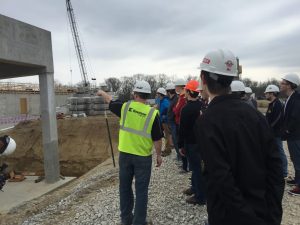CE 105 takes a trip to water treatment plant construction site
 What does it take to give one class a first-hand look at their future profession? For Hans van Leeuwen’s CE 105 class, it took two trips to the new water treatment plant being built in Ames.
What does it take to give one class a first-hand look at their future profession? For Hans van Leeuwen’s CE 105 class, it took two trips to the new water treatment plant being built in Ames.
Van Leeuwen, the Vlasta Klima Balloun Professor of Biological and Environmental Engineering at Iowa State, teaches CE 105 (Introduction to the Civil Engineering Profession) to show students some possibilities for future careers. The content of the class is a mix of teaching thinking and communication skills, as well as learning from guest speakers talking about their work in the field. “I teach different levels of learning such as analysis and resynthesis,” said Van Leeuwen. “Of particular value is critical thinking, but also lateral thinking ‘outside the box’ to solve problems that cannot be tackled with math or logic. This is how we get to new developments and inventions.”
But the most paramount experience of the course is a field trip that allows students to see the realities of their profession. The in-progress plant that the class visited is planned for completion in 2017 and will provide water treatment for Ames homes and businesses and the Iowa State campus, among other organizations and areas. The construction process has already used 10,000 cubic yards of concrete on site and they plan to use an additional 5,000 cubic yards in addition to other pre-cast concrete panels that have been transported to the site.
Civil engineering freshman Anja Schepp had never been to a construction site before the class’s trip to the plant. “No one that I know is a civil engineer,” she said. “That trip was the first time I’ve been in the walls of a construction site so I could see what they’re doing up close with the scaffolding and how they handle safety.”
In order to get all approximately 159 students in the class to the site, the field trip turned into two separate trips at different times. “It was more difficult to coordinate than I expected,” said class TA Rebecca Dailey. “It was tough, but I think students got a lot out of it so it was worth it.” Each of the two trips of 80 students required two busses in addition to many students driving their personal vehicle to the site just four miles away from campus.
Van Leeuwen said it was important that students understand the sheer vastness of construction projects. “It’s not just something you can build in a lab. There are going to be all kinds of problems like mud and weather and injuries. You can’t convey that by just showing slides.”
“It gave me a good perspective,” said Schepp. “It was freezing cold and all of the students didn’t want to be in the cold, but the workers and engineers are out there every day. It gave me respect for aspects of civil engineering other than just design.”